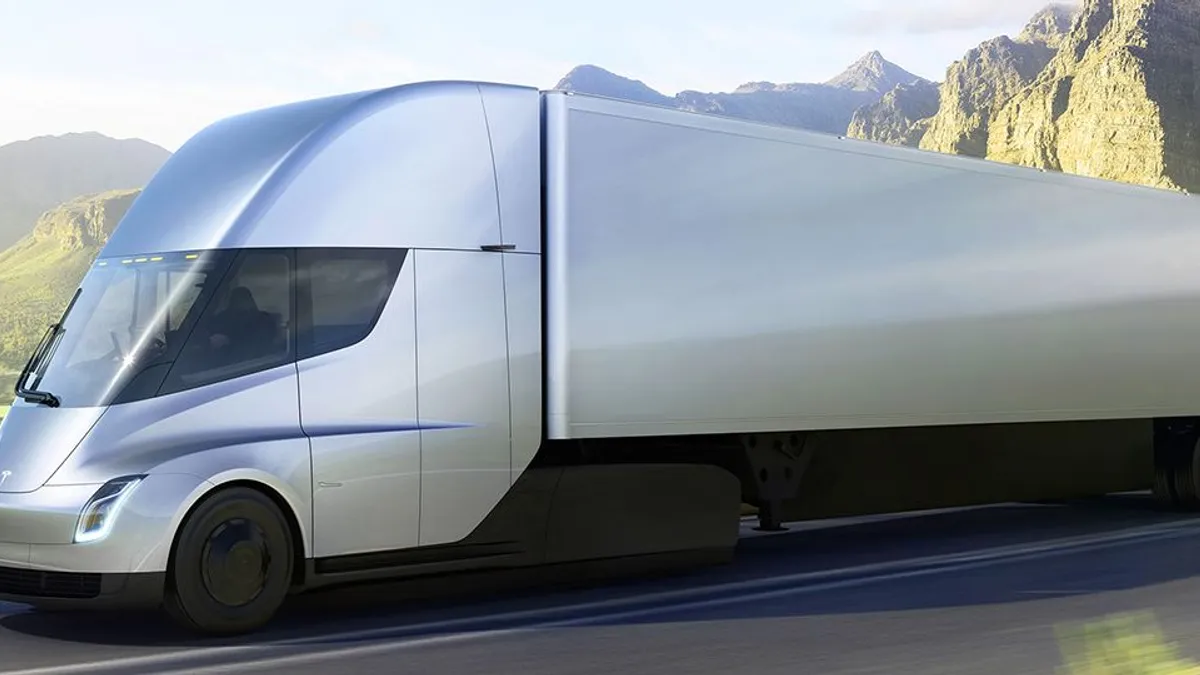Editor's Note: The following is a guest post written by Drew McElroy, co-founder and CEO of Transfix.
Tesla is not the first company to reveal an electric truck—Daimler, Volkswagen, Cummins and others got there first. The star power around Tesla and founder, Elon Musk, led the November unveiling of its semi to spark a lot of talk about what the new truck means for the industry.
Tesla won’t start production until 2019, but big players like UPS, J.B. Hunt, Pepsi and Anheuser-Busch have already bought in. In an investor note that was published by Business Insider, Morgan Stanley analyst, Adam Jonas, suggested there may already be 1,200 pre-orders.
Jonas speculated that, "The game-changing capabilities and economics of the Tesla Semi potentially set off separation between the technology leaders and the laggards among carriers, shippers, truck OEMs and suppliers."
Musk promises the moon in the semi (more details below), and some wonder if Tesla will be able to deliver given the company’s highly publicized challenges and delays in the past.
Nevertheless, it feels like an ideal moment to reflect on what the announcement — and the attention — portends for key indices:
1. Innovation
After describing all the benefits of his new truck, Musk egged on the assembled crowd: “The hell with barriers! Jump over.”
The commercial trucking industry may be hesitant to embrace digitization, but the semi announcement is just another sign that it is happening.
There are 3.63 million trucks in operation, at last official count, and they move about 70% of the U.S.’ weight by freight. That’s $762.4 billion in gross freight revenue in this country alone—quite an alluring figure.
2. Performance
After emerging from a semi, Musk went straight into performance talk.
Pulling 80,000 pounds — max gross — the semi gets to 60 mph in 20 seconds. And with a 5% grade at max gross, Musk said the semi can go 65 mph, which is 20 mph faster than the best diesel.
“If you are pulling a load over the Rockies or some mountain strain up a hill, you are earning 50% more per mile than you are in a diesel truck,” Musk told the crowd.
That said, some truckers claim that these figures still don’t make it worth the $200,000 price tag
“Haulers don’t care about these claimed figures,” the United Kingdom’s Road Haulage Association policy advisor, Rod McKenzie, told Autocar. “They’re not relevant to us. We’re not looking for performance, not least because [trucks’] speed is limited to 56mph.” Still, if true, these numbers are potentially transformative long-term.
3. Efficiency
“Electric trucks will be an everyday component of fleet operations in the very near future,” wrote Jack Roberts, senior editor of Heavy Duty Trucking Magazine.
As noted, there is significant competition already, both domestically and abroad. The semi puts a stake in the ground with a 500-mile range on a single charge; Musk is also promising a network of solar-powered Megachargers that can add another 400 miles in 30 minutes.
Fuel efficiency is further enhanced by the aerodynamic design that helps it beat a premium sports car (Cd = 0.36) and the platooning-ready “Enhanced Autopilot” system, which can steer around corners, stay in lane and stop in traffic.
4. Safety
The enhanced autopilot also means that the semi truck will brake automatically if a medical emergency prevents the driver from taking control.
This is just one of the many safety features, including a fix for one of the trucker’s biggest fears.
“Jackknifing is impossible,” Musk said. “The truck will automatically stop jackknifing because it has independent motors on each wheel. Your worst nightmare is gone with this truck.”
Also, a low center of gravity reduces the chance of rollover. All of which could be alluring in an industry where roadway fatalities for truckers are up again, and truck driving is the most dangerous profession in the country.
5. Drivers
With the buzz around autonomous vehicles, many find it interesting that Tesla paid so much attention to the driver experience. Aside from safety gains, the redesigned cabin — which has enough space to stand up and move around — puts the driver at the center, allowing for optimal visibility.
“You’re positioned like you’re in a race car,” said Musk. The dashboard is replaced with two touchscreen displays that monitor blind spots and electronic logs.
“My sense is that Tesla has shown the way forward in terms of how a near-future driver-information system is going to function, and that other OEMs will soon follow suit with vastly improved systems of their own,” Roberts, of Heavy Duty Trucking Magazine wrote.
6. Bottom Line
Of course, all of this is moot if the cost of the semi makes it unattainable for most carriers/owner-operators. Obviously, the semi is pricey.
The base price for the 300-mile range model is $180,000 (vs. around $120,000 for a traditional truck). But Musk is betting on long-term figures. He claims diesel trucks are 20% more expensive to operate than the semi, and claimed a semi owner could save $200,000 in fuel costs over the lifetime of the vehicle.
To sweeten the pot, Tesla is offering a one million-mile-no-breakdown guarantee. At this point it is still yet to be seen whether the big announcement has legs: Will these numbers hold true? Can Tesla manufacture the trucks? Is the battery realistic?
Some experts say don’t bet against Elon Musk, others hope it’s not his Waterloo moment. Only time will tell whether it’s a Tesla Semi, or someone else’s vision, coming down the pike.
Drew McElroy is co-founder and CEO of Transfix, a real-time visibility tool for tracking shipments.





















